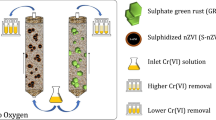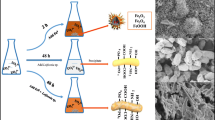Summary
The removal of uranium (VI) from zerovalent iron permeable reactive barriers and wetlands can be explained by its association with iron oxides. The long term stability of immobilized U is yet to be addressed. The present study investigates the remobilization of U(VI) from iron oxides via diverse reaction pathways (acidification, reduction, complex formation). Prior, uranium coprecipitation experiments were conducted under various conditions. The addition of various amounts of a pH-shifting agents (pyrite), an iron complexing agent (EDTA) or iron (III) reduction agent (TiCl3) yielded in uranium remobilization, concentrations above the US EPA allowedmaximum contaminant level(MCL=30 µg/l). This study demonstrates that U(VI) release in nature strongly depends on the conditions and the mechanism of its fixation by geological materials.
Similar content being viewed by others
Author information
Authors and Affiliations
Rights and permissions
About this article
Cite this article
Noubactep, C., Schöner, A., Dienemann, H. et al. Release of coprecipitated uranium from iron oxides. J Radioanal Nucl Chem 267, 21–27 (2005). https://doi.org/10.1007/s10967-006-0004-1
Issue Date:
DOI: https://doi.org/10.1007/s10967-006-0004-1




